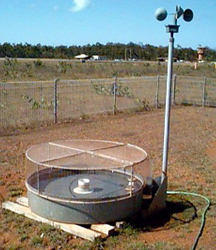4.2.4.3 When should I irrigate and how much do I apply?
Return to Main Menu | Return to Step 4 | Return to Step 4.2.4 | Next Step
Running costs are an important consideration. Irrigating in off-peak electricity supply periods can considerably reduce electricity bills. For example, 25 mm may be applied over the weekend and 15 mm applied over two or three nights during the week in an average January period. In high demand conditions, irrigating partially in peak demand periods may be necessary to apply enough water. This depends on the system capacity of the pivot –see “system capacity” in Step 4.2.2.1.
Note: Centre pivot irrigation scheduling is different from that for border-check irrigation. The machine has to run for long enough to maintain soil moisture levels within a relatively narrow range. In high demand periods, it may have to run virtually continuously, depending upon the system capacity.
An interactive graphical illustration of the impact of centre pivot and lateral move irrigation management strategies is available at Oversched (external link) on the CRC Irrigation Futures website.
Daily evaporation data is available for several centres (including Tatura, Kyabram, Mildura, Sale and Rutherglen) at Daily Weather Observations on the Bureau of Meteorology website (external link). While this data can give a good guide to evaporation, you should use your own rainfall figures rather than the reported rainfall, as rainfall is much more spatially variable. Note the while at Tatura, 0.8 of the pan evaporation figure approximates to pasture water usage, this factor may vary for other centres.
In southern NSW, daily evapotranspiration data is available for several centres for the previous fortnight at CSIRO Land and Water - Griffith Weather Data (external link). Note that the evapotranspiration data is calculated from weather station data, and is not directly equivalent to the pan evaporation data available in Victoria, but is likely to give similar results using a crop factor of 0.8 for perennial pasture.
Lucerne uses more water at its peak than perennial pasture, but after it is cut it uses much less until it regrows. At its peak, lucerne can use perhaps 20% more than perennial pasture; that is, similar to pan evaporation at Tatura. Over a cutting cycle however, the average water usage is likely to be similar to that of perennial pasture (i.e. pan evaporation X 0.8).
Page top
| Irrigation scheduling Centre pivot allows better control of water application than border-check irrigation. While many people achieve good results simply by using their judgement based on observed soil moisture and weather conditions, a centre pivot provides the potential to optimise water efficiency with a more comprehensive irrigation scheduling regime. Irrigation management decisions can be based on climatic information (evapotranspiration less rainfall, or E-R), or soil moisture measurement, or a combination of both. Over spring and autumn when irrigation requirements are variable, it is appropriate to irrigate on an evaporation less rainfall (E-R) interval, or a given soil moisture deficit. 30 mm is commonly recommended as an appropriate E-R interval for sprinkler irrigated perennial pasture in the SIR, or an equivalent 25 mm soil moisture deficit. That is, 30 mm of E-R is approximately equivalent to 25 mm of pasture water use (0.8 x (E-R) at Tatura), and this is the amount you need to replace when you irrigate. You need to allow for the application efficiency of the pivot - this can normally be assumed to be 95%, particularly when evaporation is low, but may reduced to 90% in hot windy conditions. Hence to replace 25 mm of soil moisture, you need to apply 27 mm. Over summer when irrigation demand is higher and more constant, regular irrigation (say twice per week may be more convenient, replacing the soil moisture used by the pasture. That is if E-R for the week is say 50 mm (common for January at Tatura), the pivot should apply 50 x 0.8 (40 mm), or the measured soil moisture deficiency, through the week. Allowing for application efficiency of 95%, 42 mm needs to be applied over the week. This may be applied in say two irrigations, or predominantly at the weekend and each night if using off-peak electricity. |
 Evaporation data or evapotranspiration data can guide your irrigation scheduling |
Note: Centre pivot irrigation scheduling is different from that for border-check irrigation. The machine has to run for long enough to maintain soil moisture levels within a relatively narrow range. In high demand periods, it may have to run virtually continuously, depending upon the system capacity.
An interactive graphical illustration of the impact of centre pivot and lateral move irrigation management strategies is available at Oversched (external link) on the CRC Irrigation Futures website.
Daily evaporation data is available for several centres (including Tatura, Kyabram, Mildura, Sale and Rutherglen) at Daily Weather Observations on the Bureau of Meteorology website (external link). While this data can give a good guide to evaporation, you should use your own rainfall figures rather than the reported rainfall, as rainfall is much more spatially variable. Note the while at Tatura, 0.8 of the pan evaporation figure approximates to pasture water usage, this factor may vary for other centres.
In southern NSW, daily evapotranspiration data is available for several centres for the previous fortnight at CSIRO Land and Water - Griffith Weather Data (external link). Note that the evapotranspiration data is calculated from weather station data, and is not directly equivalent to the pan evaporation data available in Victoria, but is likely to give similar results using a crop factor of 0.8 for perennial pasture.
Lucerne uses more water at its peak than perennial pasture, but after it is cut it uses much less until it regrows. At its peak, lucerne can use perhaps 20% more than perennial pasture; that is, similar to pan evaporation at Tatura. Over a cutting cycle however, the average water usage is likely to be similar to that of perennial pasture (i.e. pan evaporation X 0.8).


